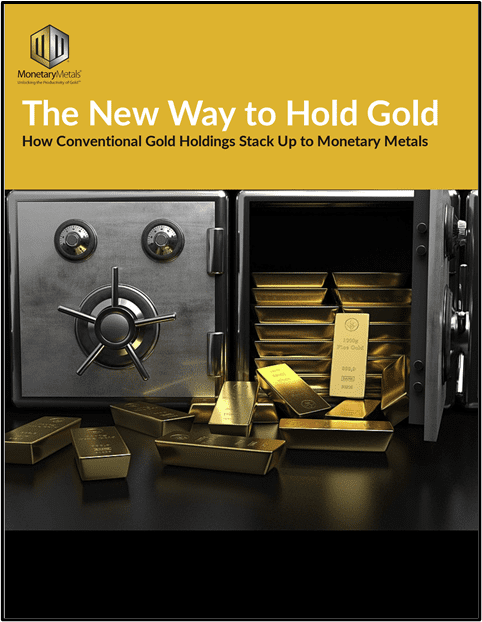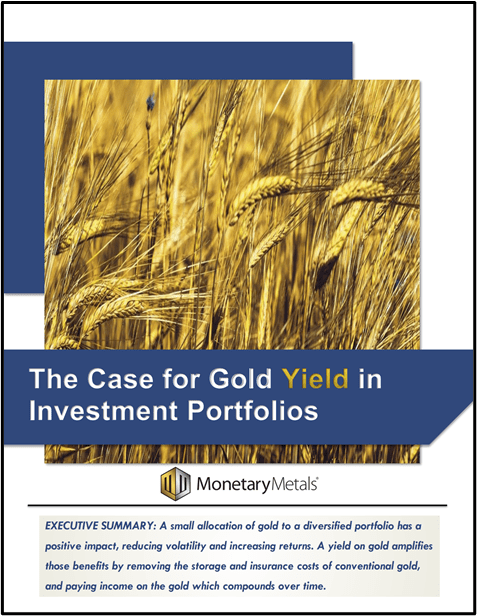Is gold an inflation hedge?
Jeff Deist and Ben Nadelstein discuss narratives surrounding the merits of gold ownership. Is gold an inflation hedge, store of value, or a safe haven asset? The episode ends with questions regarding gold’s monetary premium and the different types of inflation.
Connect with Jeff and Monetary Metals on X: @JeffDeist @Monetary_Metals
Additional Resources
Start Earning Interest on Gold
The Case for Gold Yield in an Investment Portfolio
Podcast Chapters
00:00 – Gold’s changing landscape
03:01 – Decoupling from traditional metrics
05:35 – Impact of interest rates on gold
08:45 – Safe haven vs. inflation hedge
11:01 – Long-term trends in safe haven assets
14:14 – Dollar weakness
16:30 – Gold’s financial role
17:42 – Monetary premiums
19:04 – Gold’s liquidity
20:15 – Monetary Metals
Transcript:
Ben Nadelstein:
Welcome back. My name is Ben Nadelstein. I’m joined by the General Counsel of Monetary Metals, Jeff Deist. Jeff, how are you doing this morning?
Jeff Deist:
Ben, I am fantastic. How are you?
Ben Nadelstein:
Jeff, what’s on your mind? We’ve seen a lot of headlines recently with gold. Wanted to get your take.
Jeff Deist:
Yeah, I’ve been following a lot of the big gold social media accounts and just some of the general commentary around what’s behind the price increase, especially in Q1 2024. And there’s a lot of different theories about it. But there’s also some real discrepancies in the sense that in the West, we see a pretty slim demand for physical. If you talk to the actual bullion dealers, there’s not a lot of people buying in the West. We also see outflows from ETFs in the West. And generally, Western financial advisors, by West, I basically mean Western Europe and the US, Western financial advisors are still, for the most part, advising, let’s say, a 1% position, whether that’s in physical or whether that’s in some paper ETF or future, whatever it might be.
We have to understand where is this price action. I think a lot of it, obviously, is in central bank buying. There are some good people to follow if you’re interested in that. A friend of mine named Mike Mahari, who works for Money Metals Exchange, follows that, and you can follow him on Twitter, for example. But there’s also probably some churn in the paper futures market, to be sure.
But I think a lot of this to the fact that all of our old understandings about gold might be out the window. What do I mean by that? What I mean by that is I think we’re entering a new era, and we haven’t been in anything like this, really, for over 40 years. I’m talking about basically the early 1980s until right about COVID, till about 2022, we had a four-decade period of declining interest rates. When we’re talking about gold, people talk about whether it’s a safe haven. Whether it’s inflation hedge and all these other things.
What I’m suggesting, I don’t know, but what I’m suggesting is we might be entering an era where the underlying price of gold is decoupled from a lot of these fundamentals to which we tied it in the past. In other words, what if in this new era, the price of gold is no longer tied to interest rates, whether it’s central bank rates, prime rates, commercial rates, whatever you want to look at, overnight lending rates? What if it’s no longer tied to CPI? What if it’s no longer tied to the equity and bond markets or GDP or unemployment or general sentiment?
In other words, there’s all kinds of ways that gold might be decoupling from all of these standard metrics. I would argue that that is because it is increasingly seen as a safe haven asset. I think a safe haven is a very different thing than an inflation hedge per se.
Ben Nadelstein:
One way to think about that is when When you say inflation, people think CPI. There would be an easy metric to test, which would be the CPI versus the gold price. If there was some correlation, whether that’s causation or correlation, between the gold price rising or falling and CPI rising or falling. If one stays stagnant, ideally with this framework or this narrative, the other should stay stagnant. When you look at gold prices, that’s hard to see in the data.
One might say that in the 1970s, when there was high inflation and gold prices were rising, that could just be the gold price leaving its bottled up price fix when it was actually fixed at an amount per dollar, and then just exploding to where the market price or the market clearing price should have been all those years. That’s one argument in the ’70s, yes, inflation and gold moved together, but that’s just because of other reasons, not because of CPI inflation. Then the ’80s and ’90s, that correlation, not super strong. You see inflation, but gold prices don’t necessarily track the same way. Then in the 2000s and in the 2010s, again, that story there breaks down.
Now, of course, in the 2020s, there’s a question of, Okay, we’ve had high inflation in the beginning of the 2020s. Gold price stayed relatively slow and stagnant.
Now in the 2024s, you’re seeing a rise in gold price hitting all-time highs, while inflation is not reaching new all-time highs. And some people think cooling. Paul Krugman famously saying, Everything but your food, shelter, energy, anything that you could buy. That’s all cooling. But it seems like there is a disconnect with inflation.
Another narrative has been, Okay, well, yes, maybe gold doesn’t move with inflation. It’s not an inflation hedge, but maybe it moves with interest rates, whether real interest rates or just nominal interest rates. And again, I think in 2024, that narrative has been not debunked for certain, but that decoupling, like you mentioned, is seemingly much more likely because with 5.5% target Fed funds rate at the peak, we’ve seen the gold price rise. And so most analysts say gold has no income And so the opportunity cost of holding gold while treasuries, T-bills or bonds pay five and a half %, clearly on the margin, investors might think, Well, maybe I’ll jump into T-bills. Maybe I’ll sell some gold.
Now, at Monetary Metals, we do pay a yield on gold paid in gold. So now there is an interest rate in gold. Again, it’s unaffected by the Federal Reserve and the federal reserve’s interest rate. So for some investors, that actually might be something where they say, Well, if I can earn 5 % or 3 % or 2 % on gold, that matters much less what the federal funds rate or the target rate is.
And then, of course, there’s that question of store of value, purchasing power, which I think most people weren’t born in the 1900s, so they don’t have an affinity for a 25 cent can of soup for a 50 cent stake. And so that’s maybe not a strong argument. So this flight to safety might be the new narrative. Where do you see investors or other clients thinking, Okay, if I’m looking for a flight to safety, maybe people are looking at Bitcoin. But how do you see gold in that in that new light?
Jeff Deist:
Well, I think that the safe haven concept for owning gold is more powerful than the inflation hedge. Now, I’ll go back to a couple of the metrics you mentioned. I mean, if we go back historically, gold has not always tracked inflation point by point. The other problem in that understanding is that there’s more than one inflation. Our friend Lynn Alden wrote a great article documenting three kinds of inflation, basically price inflation, asset price inflation, and monetary inflation. We have to talk about which kind we’re talking about. When even Larry Somers, of all people, comes out and says, The way we used to calculate CPI back in the ’70s and ’80s, we applied that today, it’d be a lot higher. Let’s say real price inflation. When you consider insurance and housing and tuition, medical care, go try to get homeowners insurance. If you’re a renter, guess what? Your landlord is going to have that reflected in your rent. There’s a lot of ways in which prices really are going up. We might argue cynically that the government is not very truthful and that real inflation is something more like 10%. If you look at it that way, even gold’s 2024 rise is not all that great as an inflation hedge.
We have to understand what we’re talking about. Keith Wiener is also quick to point out a lot of this is COVID-related. Supply chain shutdowns, what he calls mandatory useless ingredients, things that green energy require, that thing. There’s lots of reasons for prices to go up apart from the per se fiscal or monetary machinations of any government or central bank. We got to understand that as well. Inflation is not such a simple thing to understand. If we flip that mentality a little bit to the safe haven idea. I mean, an inflation hedge is a particular asset that is supposed to to go up in value against or ahead of inflation. A safe haven asset, by contrast, and there can be a lot of overlap, it can be the same asset in some cases, but a safe haven asset, we can define more as an asset that performs well in some, not catastrophic, but some problematic financial turmoil. A crash of 2008 and a crash of 1987, an event like 9/11, an event like COVID. We all understand the safe haven concept.
Actually, Mark Spitznagel, who runs the hedge fund Universa, that’s called a tail risk fund.
It’s a very unique and mathematical beast. But nonetheless, his central thesis, as a matter of fact, his most recent book is called Safe Haven. If you can plow through the math, which was a little challenging for me, you could actually apply a lot of his insights into your own personal investing. But the idea here is that if you keep your losses to a minimum, year after year after year after year, when that black swan or terrible event comes along, you make a killing that more than covers all of your small losses over the years. As a hedge fund manager, that’s tough. You got to have clientele who are willing to stick with you, but because of Spitznagel’s track record, he does have that clientele. When COVID came along in March of 2020, Q1 of 2020, at least one of Spitznagel’s funds made something like 4,000 % of in a single quarter. That’s a unique game, and it’s probably not something that most average investors want in their personal life. We all want to sleep at night. Mark Spitznagel is obviously a brilliant quant. We’re all not wired like that.
But still the safe haven concept, the idea that, Hey, look, I don’t have to be some perma bear.
I don’t have to think gold’s going to 5,000. That might be a very unpleasant world where it did. I don’t have to think that the world is going to get so tired of Congress’s deficits, and they’re going to stop buying our treasury debt and treasury is going to have to offer junk bond rates to get anyone to buy this crap. We don’t have to believe that there’s going to be a catastrophic implosion in the dollar or hyperinflation. We don’t have to believe that there is going to be a severe economic depression in the US or the West. We don’t have to believe any of these things to own a safe haven asset. We just have to believe that in history, these things have happened.
If you If you want to protect yourself and your family, it might be worthwhile to hold something that you think is going to perform well in that scenario.
Ben Nadelstein:
I think one way to frame this is, okay, let’s say there’s a new rule coming out saying, we’re no longer allowed to use Ubers or Airbnbs in Seattle or New York City, and that’s very plausible. You can understand why the price of those services could go up. Why the gold price would appreciate on that news is unclear to me. I’m not sure what the causation would be or even the correlation.
Now, something like the depreciation of the currency, the Lira in Turkey, I could see where the gold price actually does have a one-to-one causation, or if you want to say, correlation with the price of the Lira going down or the price of gold going up. So I could understand that. And that would, to me, seem like a safe haven narrative, which is that you are trying to save yourself from the debacement of the currency of the lira and much less likely to say, well, Uber and Airbnb are more expensive. Therefore, why is my gold price not increase it.
Jeff Deist:
Well, the other thing is you have to take a long-term view. Calamities can unfold over a decade. They can unfold over two decades. How do you define a calamity? 9/11 is a calamity. But what’s happened to the Turkish people over the last 10 years? I mean, you go back to 2011, a little more than a decade ago, the Lira was basically 2 to 1 against the Euro. Fast forward to 2024, it has gotten as high as about 20 to 1 against the Euro. So I would argue that that’s a calamity. I would argue that if you were a Turk and throughout all those years, you had been converting your paycheck from Lira into gold, you’d be, relative to your compatriots, a happier camper today.
The idea of a safe haven asset doesn’t always have to mean some immediate or instant shock. It can mean a long-term trend. On that point, let me read you a quote. This is from our friend John Hathaway at Sprott. Now, he’s talking about there’s a new understanding, which I would argue is accelerating, even since 2008, when a lot of Americans really started to question the banking system, the US dollar, the fairness of the economy, inequality, the housing, whether I’m ever going to be able to buy a house, whether I’m ever going to be able to retire.
I mean, that was a real period of reckoning, I think, for the American psyche. Let’s not forget gold markets, physical and paper. They’re a reflection of human beings, even traders, even algorithmic traders, because someone programmed the algorithm. They’re not these hyper rational robots. They have a psyche, they have greed, they have fear, they have all kinds of behaviors baked in. That’s the market, in which we have to respect the market and its signals and what it’s telling us.
Over time, as these body blows to the US psyche build, in my opinion, in any way, Iraq and Afghanistan didn’t go too well. We had the housing prices of 2008. We’ve had COVID lockdowns. We’ve had a lot of shocks over the past couple of decades. Over time, people begin to wonder, is the United States and its economy and its dollar even its military, are these paper tigers of a sort? Here’s John Hathaway. It’s probably this loss of trust in the US dollar is a safe and useful asset, is no longer a hypothetical concern. Now, I certainly agree with Brent Johnson and Santiago about the immediate or near term futures of the dollar. But I might agree with John Hathaway on the long term.
So he says abandonment of the US dollar is a reality. The pace is picking up steam. Maybe. But there are numerous potential catalysts for the general Russia and the gold by the investment mainstream. A few include the intractable fiscal position of the US. I believe that. All things geopolitical, resurgence of inflation connected to rising oil prices, an impotent and mistake-prone Fed. That is not the way people talked about the Fed when I was a young person. An unnerving setback in the overvalued and over concentrated stock market, the investment public may no longer remain asleep to these risks.
Sometimes things can be accumulated. I think that was what happened in Turkey. They borrowed an awful lot of money at the governmental level in Euro and dollars, not in Lira. They use those to fund huge infrastructure projects like airports and highways and all that. That boosts your GDP. People were talking about the Turkish economy, ’09, ’10, ’11, but then when the bills come due. You get the sense that there’s a fatigue amongst the American public, especially when they’re out seeing their paycheck price slower than inflation or their networth rise, lower than inflation. I think a lot of these body blows go to the psyche of the gold market. I think they’re reflected there.
Ben Nadelstein:
We mentioned, you don’t have to be a catastrophic doomsayer to say, Hey, I think it might be a good reason to have some gold in a portfolio. If this safe haven narrative continues to come to fruition. One of those is the price appreciation of gold over time. The other is the diversification benefit, and of course, the income opportunities through companies like Monetary Metals. What are some of your final thoughts here on terms of the inflation hedge versus the safe haven value or the safe haven narrative as we come into 2024 and 2024 heading into 2025?
Jeff Deist:
Well, I definitely think the safe haven narrative is stronger because I think that the inflation hedge is just empirically, historically not 100% accurate. I mean, it’s somewhat correlated, but it’s not precisely correlated. But more importantly, obviously, we in this company and a lot of people in our broader community, we want to see gold retain or regain some of its role in the global monetary system as a financial asset, as a monetary asset. I don’t think governments or central banks are going to go back to a gold standard anytime soon. I do think the real competitor or the real wrestling match at this point is between gold and Bitcoin. My thoughts on that are a little different than Keith Wiener’s, but nonetheless, I’m a very avid spectator.
I think the idea that there’s, at today’s dollar price, some $15 trillion worth of gold, apart from the paper market, just laying around that could be a highly productive asset in the economy, whether they’re being used as collateral, whether they’re being used as finance for production, whatever it might be. In other words, pulling some of that monetary value out of gold. I’ll finish with this. I do think gold still has monetary value in the public’s mind, in central bankers’ mind.
That’s, I think, proven in the marketplace for a very simple reason. Why does gold trade, it’s some $2,300 per ounce as of today’s show taping. Well, if gold had no monetary value, as Ben Bernanke famously told Ron Paul, Well, some of the banks just hold it because of tradition. Ron said, Why don’t they hold diamonds? It still has some monetary value, and I think that’s proved by this. If we reduced it simply to its use value as a commodity, which would basically be jewelry and industrial uses, would gold fetch $2,300 US? I think the answer to that is no.
So there’s some premium baked in that the market sets for its monetary use above and beyond its mere commodity uses. And so that monetary use reflects this idea of maybe an inflation hedge, reflects this idea of a store of value, reflects the idea that central banks hold it, reflects the idea that it historically has never really gone to zero. It reflects It’s the idea that gold is very, very liquid. It’s as liquid, at least in an ETF or something, it’s as liquid as your stocks and bonds. It’s certainly more liquid than real estate.
I think even in physical form, it’s somewhat liquid. You can go to your local bullion dealer or a bond dealer. It depends on the instant supply and demand, which is why we say, what’s the gold price? Well, there’s the LBMA London Fixed Price twice a day. Now, that very much is the paper market price. But when it comes to the physical price, that’s almost saying, what’s the real estate price? It depends on your neighborhood, it depends on your city, it depends. That’s very, very localized.
But it is this stubborn monetary value which is reflected in its dollar price per ounce, which I think shows that the world still thinks, regardless of what they said, regardless of what politicians and bankers say, the world still thinks on some level that gold has value as a monetary asset. I think we really ought to tap into that and be using gold to help people finance productive things in this world.
Ben Nadelstein:
Jeff Deist, thank you so much. For those of you interested in earning a yield on gold paid in gold, check out monetary-metals. Com. We’ll see you next time.
Jeff Deist:
Thanks, Ben.
Additional Resources for Earning Interest in Gold
If you’d like to learn more about how to earn interest on gold with Monetary Metals, check out the following resources:
In this paper, we look at how conventional gold holdings stack up to Monetary Metals Investments, which offer a Yield on Gold, Paid in Gold®. We compare retail coins, vault storage, the popular ETF – GLD, and mining stocks against Monetary Metals’ True Gold Leases.
The Case for Gold Yield in Investment Portfolios
Adding gold to a diversified portfolio of assets reduces volatility and increases returns. But how much and what about the ongoing costs? What changes when gold pays a yield? This paper answers those questions using data going back to 1972.











Leave a Reply
Want to join the discussion?Feel free to contribute!